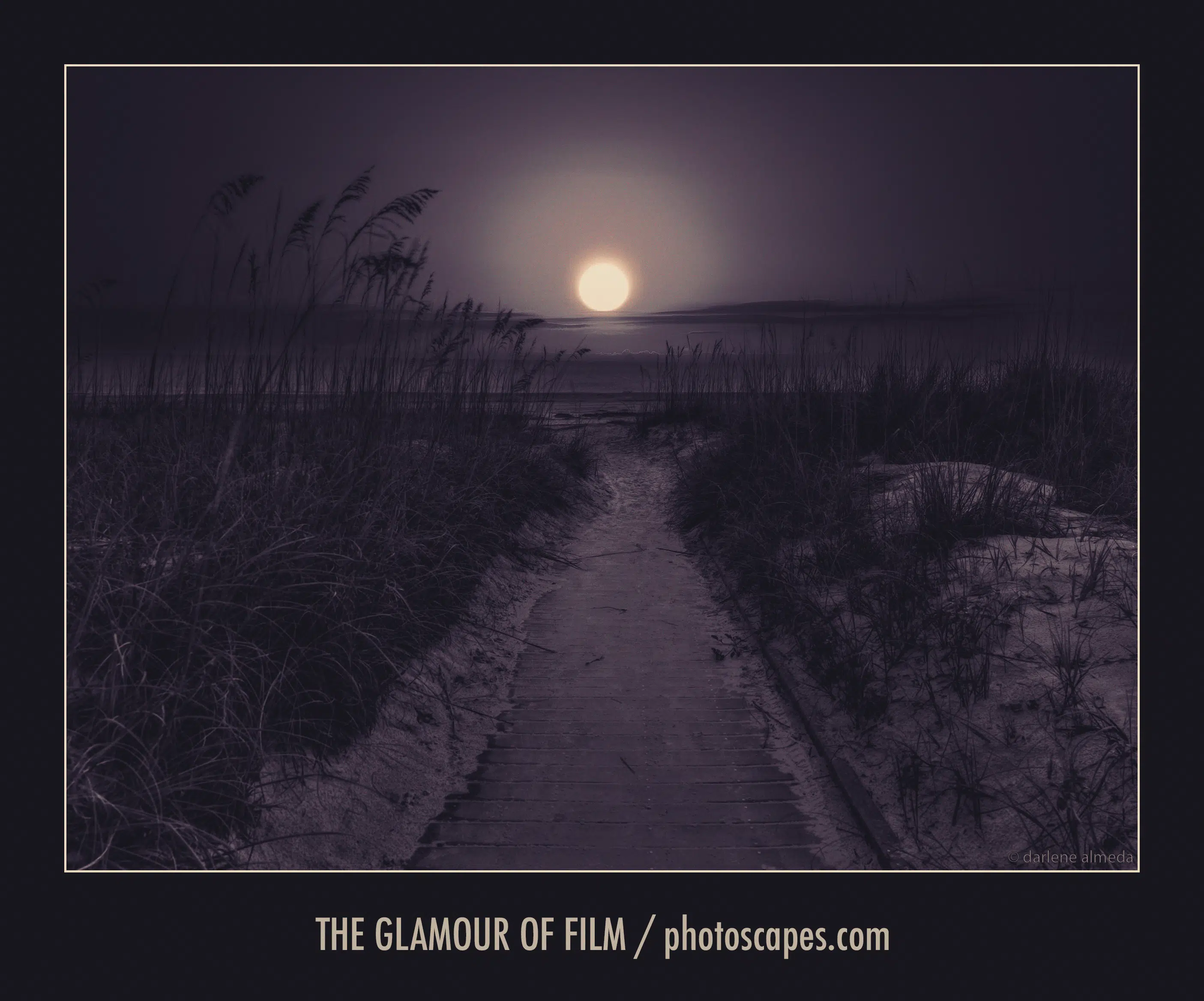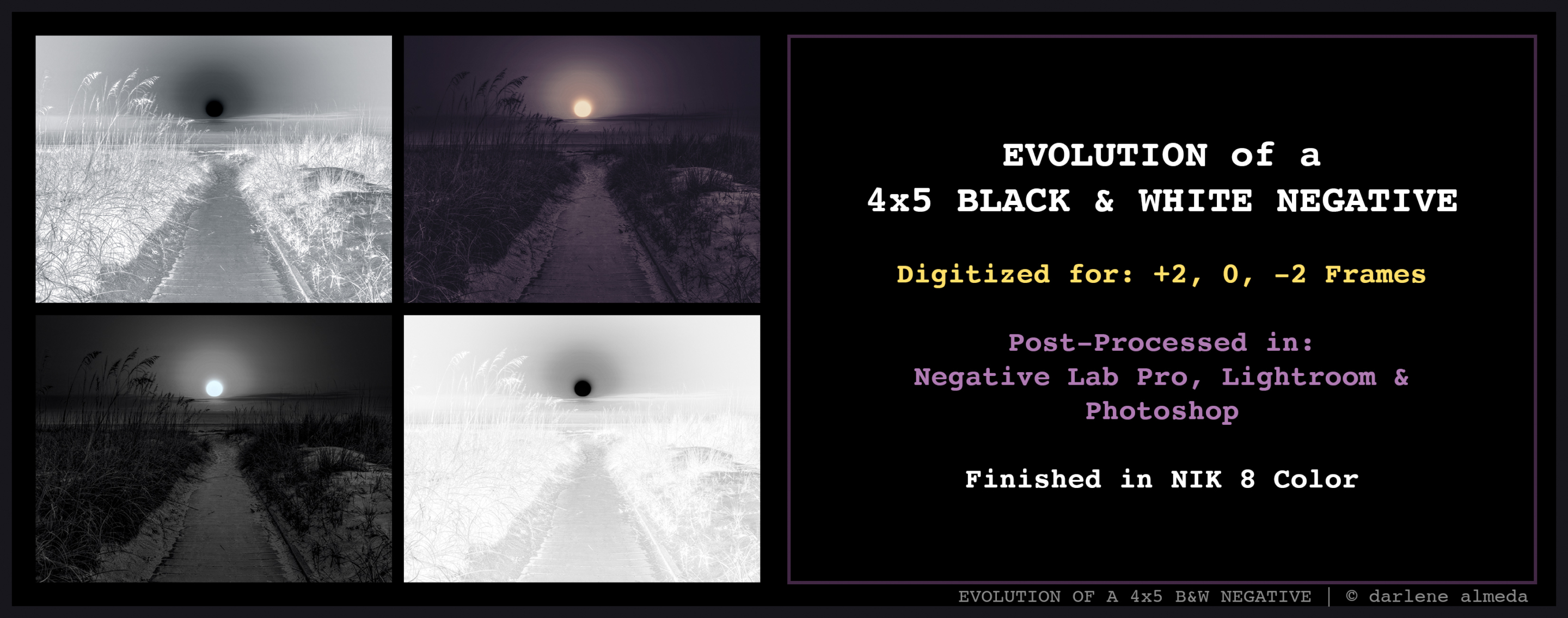
I titled this image The Glamour of Film, mostly tongue-in-cheek. Why? Because let’s be honest: there’s not much glamour in shooting film when you could be using a fast, lightweight digital camera instead.
I work in a hybrid way—the film eventually ends up beneath one of those little digital computers (a camera used for scanning), and then the files go straight to the big computer. From there, it’s like cooking a meal—I stir, season, and simmer until the image is just right.
Depending on the image, reaching the finish line can take a long time. The shooting—that’s the easy part. It always has been for me. Cameras, no matter their size or format, are just light-tight boxes. I open and close a little window (the aperture) to let in a prescribed amount of light.
Sometimes I aim to create a bright, cheerful scene. But in this case, I wanted to capture something different—the awe I felt standing on the beach at sunset, watching the moon rise with its quiet, mysterious welcome.
I knew the moment I took the shot that it would be a tricky piece of film to get right. So I took two exposures and hoped to bring them together in post. Between semi-stand developing (a 45-minute process) and digitizing bracketed frames, I gave myself room to work, hoping the final image would honor the experience I felt.

THE EVOLUTION OF THE 4×5 BLACK & WHITE NEGATIVE
Once the film was developed and dried, I let it rest in its storage binder. I knew this project needed real time to approach it with its deserved focus.
The photograph was made in June 2023, but it wasn’t until recently that I pulled out the negative and began the slow process of bringing to life what I saw and felt that evening. For me, an image like this is rooted in the desire to remember—not just what I saw, but the incredible atmosphere of being immersed in nature. The light, the mood, the quiet—it was a beautiful experience, and I needed the final image to reflect that memory.
When I made the exposure, I used a small piece of black foam core to briefly block the moon—a simple in-camera masking technique. This helped retain detail in the moon and the surrounding clouds illuminated by its glow. It provided just enough exposure control, though I knew the final shaping would happen later in post-processing.
After digitizing the film, I brought the files into my Lightroom catalog and used Lightroom’s HDR feature to blend the bracketed exposures. That’s when the image started to reflect what I had envisioned.
From there, I made a few trips in and out of Photoshop to manually blend parts of the image and tease out the moonlit clouds. I’ll admit—sometimes I forget exactly what I did. I scrapped two early versions entirely and returned to it days later with fresh eyes. Eventually, I arrived at an acceptable black-and-white version, but something was still missing.
That missing element revealed itself in the final step. I converted the file to 16-bit color and applied a subtle “midnight purple” tone using NIK Color Efex. That final color treatment brought everything together and gave the image the quiet mystery I’d felt on that beach.
IS THERE STILL GLAMOUR IN SHOOTING FILM?
Actually, yes—I think there is.
I still love the process. I love using my small but capable Ebony RSW 4×5 camera. There’s something deeply special about working with a beautifully crafted, light-tight wooden box and a manual lens. Sure, using my Hasselblad digital camera would have made things easier—but a large part of the experience would’ve been lost.
When I shoot with the 4×5, I only bring four to six sheets of film. That’s all I need. In my commercial days, I bracketed transparencies out of necessity, and that habit stuck. Bracketing has become part of my technique for handling tricky lighting on film. With digital, I’d simply enable a preset and move straight into post. It’s efficient—but far less personal.
I still shoot film because I enjoy making something by hand, through feel, judgment, and time—like cooking from scratch. That’s what brings me joy.
What about you? Do you find glamour in doing things by hand—woodworking, sewing, drawing? Maybe you also shoot and process your film.
Here’s to everyone who understands the quiet satisfaction of being immersed in a process. It might not be glamorous in the traditional sense, but it’s deeply gratifying to the soul.
